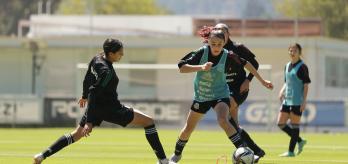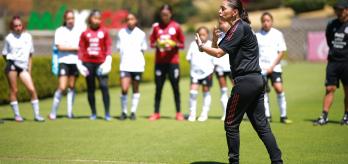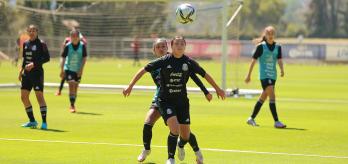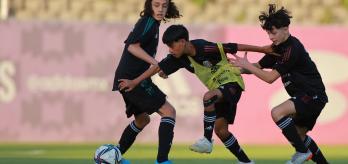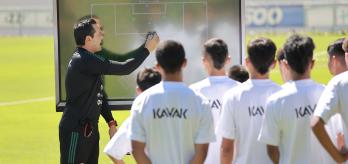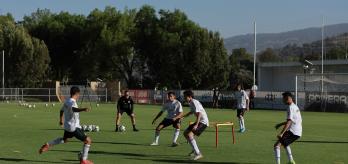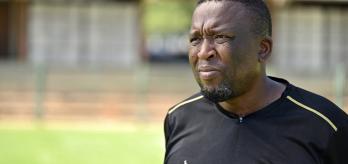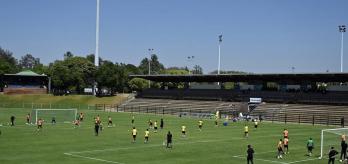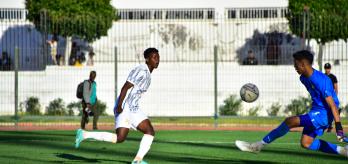Another key concept when dealing with defensive shifting is organised pressing. During the pressing phase, the team that are dispossessed must reorganise their lines quickly and form a compact block to initiate the defensive shift and the possession-recovery phase.
In this session, Karla Maya, the now former head coach of the Mexico U15 girls' national team, and her ex-assistant coach, Miguel Gamero, deliver a series of exercises focusing on defensive tactical movements and offering players the necessary information to further enhance their tactical understanding of the game.
The session begins with a circuit involving passing and runs to receive the ball that highlights the importance of body orientation when making runs to receive a pass. The second part consists of an attack v. defence exercise carried out on a pitch that is divided into channels. The exercise seeks for players to understand how to shift as a team and apply an organised press. The session finishes with an 11v11 game that brings together all of the concepts worked on during the session. The session involves 20 outfield players and 3 goalkeepers.
Session overview
Key coaching points
-
When receiving a pass, body orientation is key to bringing fluency to attacking moves.
-
Passes played into space must be weighted correctly to give the recipient an advantage ahead of the next piece of action.
-
When the defending team shift, they should do so as a unit to ensure that the movement is well organised and efficient.
-
Players should use their team-mates as a reference point to ensure that they are compact and well positioned when implementing the press.
-
Players should constantly seek information to identify free spaces and unmarked team-mates and exploit such situations efficiently.
-
Players must help out defensively when the ball bypasses them.
-
Create a blind-side press. The forward drops back to press the ball-carrying player in the midfield line without entering their line of vision, catching them by surprise and thereby increasing the chances of regaining possession.
Part 1: technical circuit
This circuit focuses on short passes, runs to receive the ball and adopting the right body orientation, which enables players to control the ball and be in a good position in relation to their opponents. The exercise is performed without opposition, but a mannequin is used to simulate an opponent.
-
Place 2 discs 20m from each other.
-
Position a mannequin halfway between the 2 discs.
-
Arrange the players, who take it in turns to perform the circuit, into groups of 4.
-
Position 2 players by the starting disc. Player A has the ball.
-
Place Player B by the mannequin and with their back to it.
-
Position Player C by the disc situated at the far end of the exercise area.
-
Player A starts the circuit by passing the ball to Player B, who, given the close attention of the opponent (the mannequin) behind them, returns the pass with a one-touch lay-off.
-
After playing the one-two, Player B peels off to one side of the mannequin and adopts the right body orientation to get the ball out of their feet.
-
Player A drives forward a few metres with the ball to draw the opponent in, before playing a pass to Player B, who controls the ball with the right body orientation and passes to Player C.
-
Player C drives forward with the ball at pace and when they reach the halfway point, passes the ball to the team-mate by the starting disc, who restarts the circuit.
-
Player A receives the return lay-off from Player B to one side of the mannequin and plays a long pass straight to Player C.
-
Player B moves to the opposite side of the mannequin to where they played the lay-off, which means that Player C has to move to the side where the ball is to create a passing lane.
-
Player B darts in front of the mannequin and Players C and B play a short, quick one-two.
-
Player C drives forward with the ball, before playing a pass to the starting position for the circuit to be restarted.
-
Player B decides which variation is performed according to the lay-off they play to Player A, i.e. into their path or to one side.
-
Passes must be firm.
-
When receiving a pass, body orientation is key to the success of the move.
-
Passes played into space must be weighted correctly to allow the recipient to run on to them.
Part 2: attack v. defence
This exercise involves an 11v11 game played on a pitch that is divided into three channels, which represent the zones through which the attacking team must circulate the ball to progress up the pitch and score a goal by connecting with the goalkeeper, who is positioned in the square marked out three quarters of the way up the pitch. The defending team seek to win the ball back as high up the pitch as possible to attack quickly and score.
-
Divide the pitch into 3 main channels.
-
Organise 2 teams comprising 11 players. The attacking team set up in a 4-3-3 formation, while the defending team are in a 3-4-1-2 system.
-
Mark out a square three quarters of the way up the pitch (the scoring zone for the attacking team).
-
Position a goalkeeper in the square.
The exercise begins with the two teams set up on the pitch and the players positioned in their respective channels. The attacking team line up in a 4-3-3 formation, while the defending team set up in a 3-4-1-2 structure.
Attacking team: 4-3-3
-
The exercise always begins with the attacking team’s goalkeeper from a goal-kick position. The goalkeeper can play a short goal kick or look to go long and connect with the forwards.
-
To score a goal, players must circulate the ball through the three channels, before connecting with the goalkeeper positioned in the square.
-
Players must constantly seek information to identify free spaces and unmarked
team-mates, which allows them to circulate the ball quickly and progress.
Defending team: 3-4-1-2
-
The defending team initially occupy the central channel, where they form a compact block. Once the exercise begins, they are allowed to occupy all of the channels.
-
Their aim is to perform a high, organised press to regain possession as high up the pitch as possible and score.
-
When the defending team shift, they should do so as a unit to ensure that the movement is well organised and efficient.
-
Players should use their team-mates as a reference point to ensure that they are compact and well positioned when implementing the press.
-
Body orientation is key to making the right decisions when controlling the ball, turning, providing a passing option and playing passes.
-
Players should constantly seek information to identify free spaces and unmarked team-mates and exploit such situations efficiently.
Part 3: 11v11 game situation
The final part of the session is a progression from the previous exercise. It once again involves an 11v11 game, but two goals are used in this exercise. One team are set up in a 4-3-3 formation and seek to build up play through possession and use the wide channels to create the width and spaces to progress up the pitch. Meanwhile, the other side act as the defending team and line up in a 3-4-1-2 system. They try to close down spaces and press as a unit to win the ball back as high up the pitch as possible and attack quickly.
-
Set up an exercise area covering three quarters of a full-size pitch and divide it into 3 zones. Place a goal at each end.
-
The wide channels are 25m wide and the central channel is 40m wide.
-
The team that start the exercise set up in a 4-3-3 formation.
-
The team that apply the high press line up in a 3-4-1-2 system in order to mark player to player and reduce the space afforded to the opposition.
-
Players are distributed in each of the zones based on their position.
-
The aim is to reinforce the concepts worked on in the previous exercises (defensive shifting and applying a high press as a unit).
-
The exercise involves no restrictions and consists of an 11v11 game played on a reduced-sized pitch. The team that start the exercise seek to progress the ball up the pitch, while the defending team try to regain possession high up the pitch to attack quickly.
Attacking team: 4-3-3
-
The ball-carrying team should look to use the wide channels to create width and spaces to progress up the pitch.
-
As a progression of the previous exercise, this team seek options to build up play and overcome the opposition’s high press.
Defending team: 3-4-1-2
-
This team apply a high press and player-to-player marking.
-
Players should be aware of their positioning at all times and use their proximity to the nearest team-mate as a reference point to ensure that they are well positioned to quickly press their opponent.
-
The players must maintain constant communication to allow the team to press high up the pitch as a unit, fill in gaps in defensive lines and close down spaces.
-
Drive with the ball to draw opposition players in and create passing lanes.
-
Players must help out defensively when the ball bypasses them.



